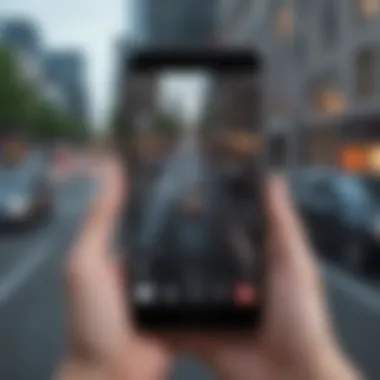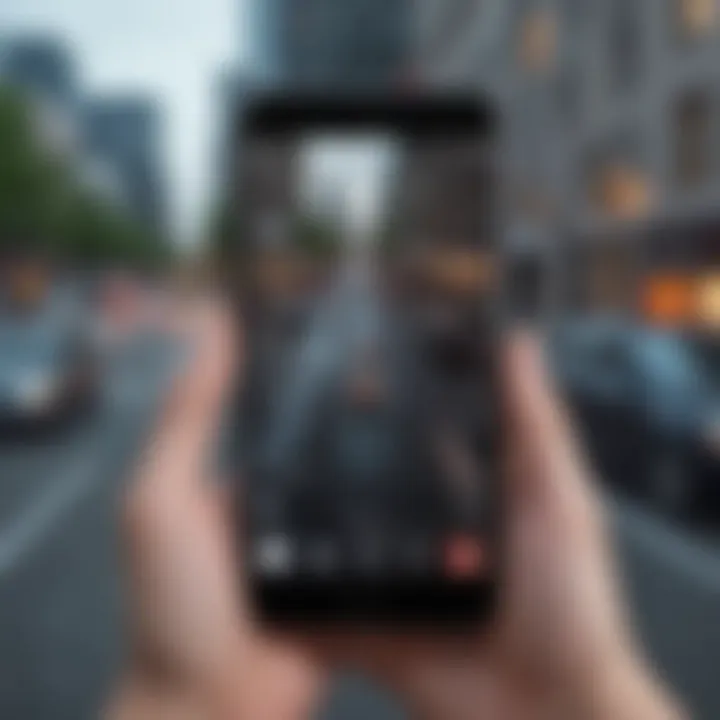Exploring the Intersection of Uber and Apple Store


Intro
In recent years, the landscape of consumer technology has witnessed notable transformations, particularly in the way we interact with services and products. The intersection of Uber and the Apple Store presents a fascinating case study of innovation, convenience, and an evolving retail ecosystem. Both organizations, though rooted in distinct industries, share a common goal of enhancing the customer experience through technology.
While Uber has revolutionized transportation with its on-demand service model, the Apple Store has redefined retail by providing a seamless buying experience for Apple aficionados. This article will delve into the nuances of how these two giants can potentially converge to create new avenues for growth and user engagement.
Product Overview
Prologue to the Apple Product Being Discussed
When discussing the innovative tools offered by Apple, one cannot overlook the significance of the iPhone. As a flagship product, the iPhone represents more than just a smartphone; it encapsulates a lifestyle for many users.
Key Features and Specifications
The latest iteration features cutting-edge specifications, including but not limited to:
- A15 Bionic chip for faster performance
- Super Retina XDR display for stunning visuals
- Pro camera system to capture professional-grade photos and videos
- Impressive battery life that lasts throughout the day
These elements not only underscore Apple’s commitment to excellence but also align with Uber's need for robust mobile technology that supports seamless service.
Design and Aesthetics
Apple is known for its sleek design and user-friendly interface. The iPhone embodies this philosophy with its minimalistic aesthetic, available in various colors, ensuring it remains a desirable accessory as much as a functional device.
Tech Integration with Uber
Performance and User Experience
A key factor in the potential success of any collaborative effort between Uber and the Apple Store is the performance of both platforms.
- It's vital to benchmark how Uber's app functions across various iPhone models.
- Apple’s investment in software capabilities ensures that every journey is tracked and managed effortlessly by users.
Users have often remarked on the smooth interface of the Uber app; however, battery drainage remains a significant concern. This can be partially mitigated through optimized features presente in newer iPhone releases, providing efficient performance while conserving battery life.
Comparison with Previous Models or Competitors
When comparing Uber's functionality on the latest iPhones to that of older models, the differences can be stark. The switching speeds, graphics rendering, and user interfaces have all significantly improved, allowing users to engage with their ride-sharing service more efficiently. Furthermore, when stacking up against competitors like Lyft, Uber has managed to maintain its edge through strategic relationships and technological enhancements in app performance.
Value Proposition
At the heart of this convergence lies a compelling value proposition: enhanced mobility. An integrated approach will allow users to enjoy the benefits of an Apple device while seamlessly interacting with Uber's services, reinforcing loyalty to both brands.
Future Outlook
As both Uber and Apple continue to innovate and adapt to market demands, the future remains uncertain yet ripe with possibilities. Integrating these platforms could lead to groundbreaking services that appeal to customers looking for more convenience in their busy lives.
In summary, the confluence of Uber's ride-sharing capabilities with Apple's retail mastery has the potential to reshape user experiences in unforeseen ways. This analysis aims to tighten the focus on these possibilities as both brands carve out their niches in an increasingly interconnected world.
Foreword to Uber and the Apple Store
The convergence of Uber and the Apple Store represents not just a blend of transport and retail, but rather a significant shift in consumer behavior and expectations. As both companies continue to carve their niches in technology, it’s essential to explore how their unique strengths might complement each other. This section introduces the ongoing dialogue between Uber's ride-hailing innovations and Apple’s meticulous retail strategy, drawing attention to the underlying dynamics that set the stage for further collaboration.
Uber, at its core, has transformed the landscape of personal transportation by leveraging technology to create a seamless connection between drivers and riders. It’s not just about getting from point A to point B; it’s about rethinking the entire travel experience. Meanwhile, the Apple Store has revolutionized retail not only by showcasing products but by offering exceptional service and an immersive customer experience. The synergy of these two brands holds incredible potential—imagine a world where purchasing a new iPhone could be accompanied by a seamless Uber ride to the store or an integration that allows in-store pickups to be conveniently arranged through the app.
Given the growing consumer demand for fluidity and convenience, it becomes critical to analyze how this intersection benefits not just the companies but most importantly, the customers. Whether it's through the ability to instantly access the latest Apple gadgets via Uber’s transportation services or harnessing Apple’s technology to enhance Uber's operational efficiency, these intersections point towards a promising horizon in product delivery and service excellence.
"The only way to do great work is to love what you do." - Steve Jobs
By examining the unique business models of both Uber and the Apple Store, we can uncover fundamental insights that inform each brand's strategy, consumer reactions, and potential future developments. The ensuing sections delve into these business frameworks, showcasing how the merging of transport and retail might signal the dawn of a new consumer-centric marketplace.
Overview of Uber's Business Model
Uber operates on a disruptive business model that has fundamentally altered transportation norms. The company utilizes a digital platform that connects riders with drivers through a simple, user-friendly app interface. With dynamic pricing and the ability to track rides in real-time, Uber emphasizes convenience and efficiency.


Uber’s primary revenue comes from a percentage of the fare charged for each ride, which incentivizes constant innovation in their service offerings. Additionally, Uber has expanded its scope by venturing into food delivery through Uber Eats and freight transportation, fortifying its role as a versatile service provider.
The emphasis is on user experience—minimal wait times and intuitive app functionality. This user-first approach has played a pivotal role in creating a loyal customer base that values trust and reliability in their transportation choices.
Overview of the Apple Store's Retail Strategy
The Apple Store was conceptualized as more than just a place to sell gadgets; it’s a holistic retail experience. Apple employs a strategy built around providing customers with a deep understanding of its products, delivered through well-trained staff in beautifully designed spaces. Each store is meticulously planned, from layout to customer engagement tactics, aiming to create a lasting brand impression.
Key elements of Apple’s retail strategy include:
- Personalized Service: Staff, known as "Geniuses," are equipped to help customers address their specific needs, ensuring a knowledgeable and tailored shopping experience.
- Experience Focus: Apple encourages customers to interact with products through demos and workshops, fostering an environment of learning and exploration.
- Seamless Integration: The use of technology is evident in the way transactions are processed; mobile payments via Apple Pay link back to their emphasis on tech convenience.
The Technological Framework
The convergence of Uber and the Apple Store lies not only in their respective services but also in the sophisticated technological frameworks that underpin these operations. Both entities thrive on innovation, constantly seeking ways to enhance user experience while pushing the boundaries of what's possible in their industries. The technological framework acts as a backbone for integrating services, streamlining processes, and ensuring an elevated user experience. Understanding this intersection is vital not only for tech-savvy consumers but also for industry professionals keen on tapping into emerging trends.
App Integration Scenarios
Today, mobile applications orchestrate our daily lives, none more so than the seminal contributions made by Uber and the Apple Store. One possible integration scenario involves the seamless booking of Uber rides through the Apple Store app itself. Imagine a scenario where, upon releasing a new product, users can reserve a ride to the nearest Apple Store, ensuring they arrive on time to grab the latest tech. Such a feature makes the lives of consumers easier and enhances the likelihood that they will purchase on launch day—hence intertwining transportation services directly with retail strategies.
Additionally, integrating features like location-based services allows consumers to receive notifications when they are near or if there are promotions available at the Apple Store. This practicality adds value to both apps, creating a symbiotic relationship that benefits both the ride service and the retailer.
- Real-Time Availability: Displaying nearby Uber vehicles in the Apple Store app could provide real-time options.
- In-App Booking: Allowing Uber ride bookings directly from the Apple Store enhances convenience.
- Payment Integration: Synchronizing payment methods between the two applications could streamline the purchase experience for users.
Enhancing User Experience through Technology
The synergy between Uber and the Apple Store is rooted in the enhancement of user experience. Each brand offers an array of touchpoints that can be amplified through technological integration. The potential lies in personalized experiences tailored to individual preferences. For instance, knowledge from past purchases and ride selections can inform features like customized promotional offers.
Smart devices in the stores could display trending rides based on consumer interests or even version alerts to notify users about product upgrades or availability. In this scenario, both Uber and Apple gain valuable insights into consumer behavior, feeding data back to improve services further.
Furthermore, innovative technology such as augmented reality could offer users virtual demonstrations of products while they wait for rides. Picture this: a customer waiting for their Uber inside an Apple store could use AR to see how a new iPhone might fit into their daily routines. This not only keeps them engaged but also enhances their anticipation for the purchase.
"By embracing the technological synergies, both Uber and the Apple Store can turn interactions into memorable experiences that extend beyond traditional customer service."
Customer Interaction and Service Excellence
In today’s fast-paced world, where customer expectations are constantly evolving, the interplay between customer interaction and service excellence has become increasingly critical for businesses like Uber and the Apple Store. Both entities have established themselves as leaders in their respective domains, but it is their ability to engage customers and provide an exceptional service experience that truly sets them apart. This section delves into the intricacies of customer interaction and how it feeds into maintaining service excellence, ultimately benefiting both businesses and their clientele.
Staff Training in a Dual-Service Environment
Staff training is absolutely essential, particularly in the context of a dual-service environment where two different service models intersect. At Uber, drivers are not just transporters; they are ambassadors of the brand, and they need to realize the weight of that responsibility. On the other side, Apple Store employees, often referred to as "Geniuses," must have an in-depth understanding of Apple products and services. Hence, the crossover of these models demands a tailored training approach.
To provide stellar customer service, it is crucial that both Uber and Apple invest in training programs. For Uber, drivers must familiarize themselves not only with the app but also with the nuances of customer service. Training could include practical workshops on interaction techniques, cultural sensitivity, and conflict resolution.
For Apple, the challenge lies in training their staff to understand Uber's services as well. Employees should be equipped with knowledge about how ride-sharing can complement the retail experience. Additionally, cross-training employees in both environments can create a seamless experience for customers, where clarity and assistance are at the forefront of every interaction.
Improved Access and Convenience
When it comes to customer interaction, one major factor that cannot be overlooked is the level of access and convenience provided to users. Uber excels at delivering convenience through its ride-sharing platform, and Apple’s retail experience strives for high accessibility. The convergence of these two services holds the promise of significantly enhancing user experience.
Consider the scenario where an Apple Store launches a highly anticipated product. Customers often face long lines and limited access when they try to get their hands on the latest devices. By integrating Uber’s services, Apple can create a streamlined approach. For instance, customers could pre-order products through the Apple app, and then they can use Uber to select a specific time for pickup. This eliminates waiting times at the store, thus ensuring a hassle-free experience.
Furthermore, both companies use technology to enhance access. For instance, an integrated app platform could facilitate scheduling pickups directly from the Apple Store to a customer’s chosen destination, maximally boosting convenience. It’s not just about minimizing the obstacles for consumers; it’s about redefining customer interaction to ensure satisfaction and loyalty.
"In customer service, the more accessible you are, the more trustworthy your brand becomes. As rides and retail converge, convenience is one key to success."
In summary, the synergy between Uber and the Apple Store showcases the significance of customer interaction and service excellence. By focusing on staff training and improving access, these companies can deliver an enriched experience that encourages loyalty and positive customer engagement. The steps they take now will lay the groundwork for the future—a future where ease of use and customer-centric strategies rule the landscape.
Implications for Product Offerings
The intersection of Uber and the Apple Store reveals intriguing possibilities for enhancing product offerings. Both entities grasp the importance of not just meeting customer expectations but exceeding them through innovative collaboration. When Uber integrates its transportation services with Apple’s retail experience, the implications stretch far and wide, impacting marketing strategies, customer services, and the general dynamism of product deliveries.
Potential for Special Transport Services for Product Launches
As Apple continues to launch groundbreaking products, the logistics behind these events become vital. Utilizing Uber's transportation network for special product launches can provide a unique flair. Consider the last iPhone launch where hundreds of excited Apple fans flock to the store. What if, during that launch, Uber offered exclusive rides directly to the event? This isn’t just about convenience; it’s about creating an experience.


By having designated Uber rides for fans, Apple can collect data on who is engaging with their products and create targeted marketing strategies post-launch. This synergy can not only facilitate a smoother flow of consumers but also elevate Apple’s brand image as tech-savvy and customer-oriented.
- Attraction for Influencers: Imagine social media influencers arriving in a branded Uber, capturing their grand entrance live for millions of followers, resulting in organic promotion.
- Real-time Data Collection: Each ride can provide data about consumer preferences, commute times, and more.
- Enhanced Customer Experience: By providing ride services, customers feel valued, fostering loyalty.
Impact on Overall Sales Strategy
Apple's retail strategy has always hinged upon an elite shopping experience and technological integration. By partnering with Uber, Apple could refine its sales approach based on real-time tracking and analytics.
An essential element is to look at customer patterns. If Apple understands that certain demographics prefer Uber for visits to physical locations, they can adjust marketing initiatives accordingly, focusing advertisements specifically where they resonate most. It can be as straightforward as offering a discount code for a ride to the store when a new product drops.
- Increased Foot Traffic: People are more likely to visit if transportation isn’t an issue, especially during peak times.
- Promotion of Bundled Services: Apple can partner with Uber to create bundles that offer discounts on ride fares when purchasing high-end items in-store.
- Localized Marketing: With data collected, Apple can localize marketing efforts based on where most consumers travel from.
Combining Uber’s transportation capabilities with Apple’s stores can create a seamless ecosystem that not only meets consumer demands but anticipates them, paving the way for innovative sales strategies and enriching customer experiences.
As these two massive brands explore their interconnectedness, the implications for product offerings become a fascinating study in customer-centric planning and operational efficiency.
Market Analysis of Collaborative Opportunities
The significance of examining the convergence between Uber and the Apple Store lies in understanding how these two titans in their respective fields can create symbiotic benefits for both brands. In a market driven by enhanced customer experiences, the potentials of collaboration are ripe. For Uber, aligning with Apple's robust retail ecosystem opens avenues to increase visibility while reaching tech-savvy consumers who rely heavily on seamless integration among devices. Conversely, the Apple Store gains from enhancing customer touchpoints through transportation convenience. The outcome of such synergy could lead to a smoother retail experience, showcasing the importance of this analysis.
Case Studies of Similar Partnerships
Partnerships like that of Starbucks and Uber Eats demonstrate how strategic alliances enhance customer experience. For instance, Starbucks customers can order their favorite coffee through the Starbucks app and get it delivered via Uber Eats. This collaboration illustrates how service integration fosters convenience. Similarly, analyzing the collaboration of Amazon and Whole Foods sheds light on the brick-and-mortar approach. Amazon took physical presence to support its online strategy, while integrating technology for efficiency in customer interactions. Actions, such as these, provide valuable insights into the potential marriage of Uber with the Apple Store, where a customer driven model can flourish.
Consumer Trends and Preferences
Consumer behavior indicates a strong inclination toward convenience and integration. According to studies, about 60% of consumers prefer services that allow them to partake in multiple functionalities through a single platform. This trend suggests that a unified experience can drive customer loyalty. Apple users are noted for being brand loyal. When considering Uber, it could attract Apple enthusiasts who desire cohesive interactions, such as a ride to the Apple Store while ordering products online simultaneously.
"This shift towards integrated services is not just a fad; it's a movement toward efficiency that modern consumers crave."
Thus, understanding these consumer preferences shapes how both brands can pivot effectively within their respective industries. The melding of services proposes new ways for user engagement, directly impacting sales and customer satisfaction.
Regulatory and Operational Challenges
In any analysis of collaborative business ventures, the undercurrents of regulatory and operational challenges cannot be overlooked. This intersection where Uber's dynamic ride-sharing model meets the thoughtfully crafted retail ecosystem of the Apple Store is particularly susceptible to a variety of hurdles that could stymie potential synergies.
Taking a closer look, it becomes evident that navigation through compliance in transportation services carries immense weight. Regulatory frameworks vary vastly between jurisdictions, often creating inconsistency in how Uber's services get perceived and integrated within various locales. An Uber car, for instance, might be welcomed with open arms in California, but face a mountain of restrictions in a city like London. These discrepancies emphasize a fundamental need for both organizations to coordinate and align on compliance.
Not only that, but the operational side of things presents its own unique set of challenges. Effective coordination between the two companies will necessitate a meticulous approach in streamlining logistics, data-sharing protocols, and customer interfacing. There's significant value to integrate Uber's picking-up customers into an Apple Store visit, making sure the timing is just right, and no one is left in the lurch.
Organizational agility emerges as a prime advantage in tackling these regulatory frameworks. Companies like Uber, with their constant evolution and adaptation, can foster a culture that embraces compliance while remaining innovative. Apple, on the other hand, is known for its discretion; thus, it needs to break down silos within departments to enhance swift reaction to regulatory changes.
To conclude, understanding and addressing regulatory and operational challenges becomes not merely an afterthought but rather a cornerstone. Successfully navigating these waters can turn potential roadblocks into stepping stones for more innovative and customer-centric initiatives.
Navigating Compliance in Transportation Services
Operating in the ride-sharing domain calls for due diligence in the realm of compliance. It’s a bit like walking a tightrope; one misstep could lead to repercussions that affect not just Uber but could ripple through to affect Apple as well. Uber's business model, which relies heavily on flexibly maneuvering through varying regulations, poses questions about how it integrates with a corporate giant like Apple, known for its exacting standards.
The most pressing issues revolve around safety standards, insurance requirements, and driver background checks. Regulatory bodies have established protocols that Uber must adhere to in order to avoid hefty fines or operational shutdowns. Apple, famous for its premium services and products, will not want any association that could undermine its brand integrity. However, there's a silver lining.
"A well-owned process toward compliance not only mitigates risk but can enhance customer trust, potentially elevating both brands in the eyes of consumers."
This synergy demands that both entities stay updated with evolving legislation and work collaboratively to ensure comprehensive compliance. They could, for instance, develop a shared framework that aligns Uber's ride-sharing services with Apple Store's customer expectations—safety first, functionality second. Such a partnership can pave the way for a more robust customer experience, whereby the act of getting to the Apple Store is as seamless as buying a product once they arrive.
Impact on Apple's Brand Image
Diving deeper into how innovative partnerships shape brand identity, the impact on Apple’s brand image is multi-faceted. As a leader in technology, Apple has built a reputation around quality and user experience; any association that veers outside this image could backfire. One of the primary considerations here is how Uber’s sometimes contentious reputation in various markets aligns or contrasts with Apple's established prestige.
On one hand, this convergence offers a compelling narrative of groundbreaking convenience, appealing to tech-savvy consumers who crave easy solutions. Imagine the marketing angles, where an Apple Store visit tied to an Uber ride transforms into a seamless experience, particularly during device launches or special promotions.
On the contrary, however, if anything were to go awry—say, an Uber driver being involved in an incident—it could easily tarnish Apple's image. Maintaining quality control over this collaboration deserves meticulous attention to detail, something that needs prioritizing at both organizational levels.
Ultimately, how the brands navigate challenges and cooperate will reflect crucially on both their images. Opting for collaborative innovation rather than reactive measures toward existing challenges will serve both companies well, cementing their positions in consumer minds as modern and resourceful leaders in their fields.


Sustainability and Ethical Considerations
The topic of sustainability within the context of the convergence between Uber and the Apple Store is increasingly important as both organizations redefine how they operate and impact society. In recent years, there has been a noticeable shift in consumer attitude toward sustainability.
As tech-savvy individuals who typically frequent the Apple Store are more aware of environmental issues, brands are being held responsible for their practices. They want to see companies take concrete steps toward sustainability. In this light, any collaboration between Uber and Apple carries the weight of public expectation, with scrutiny on both entities regarding their contribution to environmental welfare and ethical business practices.
Benefits of Sustainable Practices:
- Enhanced Brand Loyalty: A proactive approach to sustainability can lead to a stronger emotional connection with consumers, thus enhancing brand loyalty.
- Regulatory Compliance: As environmental laws tighten, being ahead of the curve can prevent companies from facing penalties down the line.
- Cost Efficiency: Sustainable practices often lead to lower operational costs. For example, eco-friendly technologies can reduce energy bills.
Key Considerations:
- Transparency is Key: Both companies will need to be open about their sustainability initiatives. Customers are increasingly interested in how products are made and where they come from.
- Collaborative Efforts: Effective partnerships can amplify the impact. If Uber were to use greener vehicle solutions and the Apple Store supports this through promotional activities, they're jointly endorsing sustainable behaviors.
"Consumers are not just investing in products; they are investing in ideals that resonate with their values."
Evaluating Environmental Impacts
Every partnership involves an assessment of how the collaboration affects the environment. Uber's transport services contribute to carbon emissions. However, the company has been exploring electric and hybrid cars in its fleet. They are taking steps like the introduction of Uber Green, which connects riders with drivers using electric vehicles. The Apple Store can leverage this initiative to promote a greener image.
Additionally, Apple has a strong commitment to reducing its carbon footprint. Nearly all of its materials are sourced sustainably, and their products are manufactured using 100 percent renewable energy. Therefore, the combination of these two approaches can lead to a significant reduction in the overall carbon impact of both organizations.
Social Responsibility Initiatives
As the partnership unfolds, it can manifest in social responsibility initiatives tailored to local communities. Uber has its own driver support programs that focus on creating a fair working environment. If the Apple Store integrates these values, they can enhance this narrative of inclusiveness and fairness. A joint initiative could focus on giving back to the community through tech education programs, such as coding workshops for underprivileged youth.
Both companies have unique platforms to inspire action. Uber can provide transportation solutions to young learners for Apple-sponsored events, thereby increasing accessibility while reinforcing their social commitment. Apple's presence in the market allows them to spotlight issues that matter to consumers and initiate campaigns that promote their shared principles of sustainability and corporate responsibility.
Future Outlook for Uber and the Apple Store
The convergence of Uber's dynamic transportation landscape with the Apple Store's retail environment offers a glimpse into a future that could redefine consumer experiences. Understanding this future outlook isn't just about forecasting — it is about recognizing how both brands can synergize to create enhanced value for customers.
As technology continues to advance and consumer expectations evolve, the potential for integrated services between Uber and the Apple Store grows. These innovations can manifest in various forms, including sophisticated app integrations, personalized customer experiences, and efficient logistics solutions. Not only do these elements enhance convenience, but they also position both companies at the forefront of their respective industries.
Emerging Trends in Transportation Technology
As we gaze into the horizon of transportation technology, several trends are emerging that can significantly impact the way Uber operates. For instance:
- Electric Vehicles: With a growing emphasis on sustainability, Uber has started integrating electric vehicles into its fleet. This shift not only reduces emissions but also aligns well with Apple's ethos of environmental sustainability.
- Autonomous Driving: Self-driving cars are gaining traction. As this technology matures, it could change the efficiencies of ride-sharing, making transportation safer and more reliable.
- Mobility as a Service (MaaS): This trend promotes the idea of a seamless experience where users can access various modes of transport, including ridesharing, all from a single application. This could lead to potential apps where users book Uber rides straight from their Apple device, integrating their schedules, preferences, and more.
These trends suggest that Uber is not just looking to keep pace with current technology; it aims to lead the charge. By aligning with Apple's ability to influence user behavior through its products, Uber can enhance its service offering in a way that feels both intuitive and indispensable.
Potential Innovations in Retail Experience
Looking ahead, the Apple Store can substantially transform how consumers shop by incorporating ride-sharing services like Uber into its retail experience. Key innovations might include:
- Exclusive Service Deals: Imagine an Apple Store promo that provides a discount on Uber rides when purchasing certain products. This could encourage foot traffic while also creating a seamless experience for customers.
- In-App Store Events: Users could reserve exclusive in-store experiences or product launches via the Uber app. This can create excitement and anticipation while offering a sense of exclusivity to customers.
- Enhanced Onboarding: New customers could schedule a ride to their nearest Apple Store, with Uber drivers equipped to provide basic product information. This could be a game-changer for those who feel overwhelmed by technology.
Incorporating these types of innovations could redefine the retail experience. It allows Apple to leverage Uber's vast network while providing significant conveniences to consumers, creating loyalty that both companies can benefit from.
Both Uber and Apple are pioneering giants. Their collaboration could set new standards in technology and customer service that resonate across industries.
Culmination
In this analytical journey, we've explored the intricate relationship between Uber and the Apple Store that paints a vivid picture of modern retail and transportation partnerships. As these two giants navigate their way through an ever-evolving landscape, the convergence of their services offers significant insights into the future of convenience and innovation. This exploration is not merely an examination of two separate entities; it serves as a window into how transforming consumer expectations are reshaping industries around the globe.
Summary of Key Insights
- Interconnectivity in Services: The integration of Uber's efficient transport services with the Apple Store creates a seamless experience for users, allowing customers to journey from selecting a product online to acquiring it in-store.
- Technological Synergy: Both brands leverage technology effectively, from Uber’s cutting-edge app functionalities to Apple’s retail innovations, showcasing the potential for enhanced customer engagement through digital channels.
- Consumer Convenience: Meetings of the two companies provide benefits such as on-demand transportation for product launches, substantially increasing customer access to new products while reducing wait times.
- Market Responsiveness: The partnership presents a new model for responding to market trends where customer preferences lean towards immediacy and ease of access, a significant consideration for retailers today.
According to industry experts, the collision between these brands exemplifies the shift towards an environment where convenience and immediacy are king.
"The boundaries between tech companies and traditional retail are dissolving, leading to unique partnerships that redefine what convenience means for consumers."
Final Thoughts on Future Collaborations
Looking ahead, the potential for collaborations between Uber and the Apple Store appears vast. Each entity can draw upon the strengths of the other, enhancing the user experience comprehensively. Future collaborations could focus on:
- Innovative Delivery Systems: Imagine a scenario where the Apple Store uses Uber’s drivers for rapid delivery of products, transforming customer interaction altogether.
- Enhanced Loyalty Programs: Merging loyalty programs could incentivize customers, blending the convenience of ride-sharing with exclusive rewards from Apple.
- Sustainability Initiatives: Both companies must also acknowledge the importance of sustainability. Innovations in eco-friendly transport linked to the Apple Store could resonate well with socially conscious consumers.
The collaboration between Uber and the Apple Store serves as a prototype for future partnerships in the tech and retail sectors. Remaining agile and customer-focused will be key for both brands as they adapt to the dynamic preferences of a rapidly evolving market.



